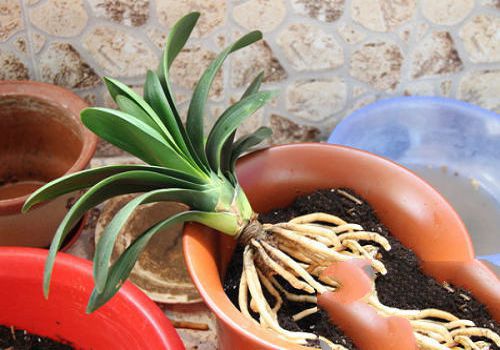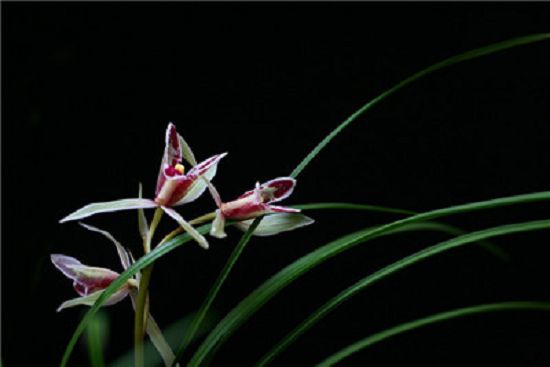Key points of maintenance and management of orchids in winter
In order to maintain and manage orchids well in winter, different management measures must be taken according to different varieties and characteristics of orchids.
First, to enter the room to keep warm into winter, the outdoor orchids must be moved into the place where the indoor sun can shine. For people living in buildings, it is better to put the orchid pots in the sunny closed balcony. For overwintering orchids, the room temperature should be controlled between 5-15 ℃. If the room temperature is too low, it will not play the role of preventing cold and keeping warm. If the flower stem is too high, the growth of the flower stem is slow, and the development of the flower bud is poor, which is easy to make the formed bud shrink and die. Because the orchid is more hardy, it needs a low temperature of about 0 ℃ in 3-4 weeks to complete the function of spring dormancy and vernalization, and then the orchid can blossom. Therefore, it is most suitable for Cymbidium to control the room temperature between 3-8 ℃.
Second, it is necessary to control fertilizer and increase light orchid hibernation period generally does not need fertilization. However, during the growth period, the orchid can be sprayed with a small amount of phosphorus and potassium fertilizer on the leaf surface, and can be sprayed with 1500 times 0.2% Mel 0.3% potassium dihydrogen phosphate or compound trace elements. In addition, the orchid can give more light indoors, and if the light is not enough, it can be supplemented by light. if the orchid has sufficient light in winter, it is beneficial to the growth and flowering of the following year, and can also improve the cold resistance of the orchid overwintering.
Third, it is necessary to control watering "not to be dry in summer and autumn and not to be wet in winter and spring". This is the orchid cultivation experience summarized by our predecessors. Orchids are mostly dormant in winter, and their physiological functions almost stop. at this time, less water is needed, and the basin soil is slightly moist to survive the winter safely. If the basin soil is really dry, spray it with water close to room temperature around noon in sunny and warm weather, so that the basin soil is slightly wet and do not flood, so as to prevent the basin soil from being too wet and rotten.
Fourth, the orchid should be ventilated in time. Orchids like to be warm and need ventilation, fearing the pollution of smoke and dust. In winter in the north, people light more stoves to keep warm indoors, and there are many foul gases in the room, so the orchid basin should be kept away from the stove at this time. At the same time, you should open the doors and windows for ventilation around noon in the sunny weather, and you can also put the end of the orchid basin to the outdoor shelter to see the sun, so that the orchid plant can breathe fresh air.
Potted wild orchid, with the passage of time, its rich fragrance will fade year by year, if through artificial adjustment, as far as possible to meet the environmental conditions of orchid, it can maintain the original fragrance.
First, the rational selection of flowerpots and pot soil wild orchids generally account for more than 80% of the humus content for a long time. In general, the humus content in the potted soil of domestic orchids is only about 40%, which is disadvantageous to the strong plant, bud and flowering of orchids. Therefore, when selecting and making potted soil, domestic orchids should choose 3 parts of edible wormwood dregs, 3 parts of dried cow dung, 2 parts of dried chicken and duck dung and 2 parts of sandy garden soil. This kind of culture soil organic humus content is generally more than 80%, fertile and loose, ventilated and moisturized, suitable for orchid growth, conducive to bud pregnancy, flowering and maintaining the strong fragrance of orchids.
Second, increasing the application of phosphorus and potassium fertilizer is an important element for orchid root growth, health, bud pregnancy and fragrant honeydew production. Therefore, during the growing period of the orchid, attention should be paid to watering the rotten bean cake water and soy sauce residue water once a month, and some plant ash is often applied to the orchid in winter and spring, and 0.1% potassium dihydrogen phosphate is sprayed 1-2 times a month in spring, summer and autumn, so that the orchid plant grows healthily, the leaves are thick and green, the stress resistance is strong, the nutrient accumulation is high, and the production of aromatic honeydew is good, which plays a significant role in restoring and maintaining the fragrance of the orchid.
Third, taboo pot soil over-dry and wet orchid should greatly reduce moisture in winter, but if the basin soil is too dry, it is easy to cause the false bulb of orchid to shrivel, and other tissues will affect metabolism due to excessive loss of water surface, resulting in poor plant growth and leaf withering and even death. If the pot soil is too wet, its ventilation is poor, it is easy to cause rotten roots and poor growth, and the flowers will lose their fragrance.
Fourth, raise the temperature of cold orchid, cymbidium and spring orchid blooming in winter and spring, in order to keep the potted orchid growing healthily and safely through the winter, in the cold season, it is necessary to close the doors and windows and keep the indoor temperature at about 10 ℃ during the day and at least 5 ℃ at night, in order to meet the temperature needed by the incense spill.
Related
- Is the orchid suitable for indoor use? Is it good for the body?
- How to prevent the empty root of orchids?
- What to do after the crab claw orchid is withered?
- Why are the leaves of orchids always yellow? Fertilizing and watering.
- Can the root of the gentleman orchid be saved if it is rotten?
- Diagnosis and treatment of cotton-blowing beetle insects in Cymbidium
- There is a way for a gentleman's orchid to rot.
- What is the most suitable temperature and humidity for the orchid?
- How to raise a gentleman's orchid? Cultivation techniques of Cymbidium
- How to prepare the nutritive soil for the cultivation of Cymbidium



